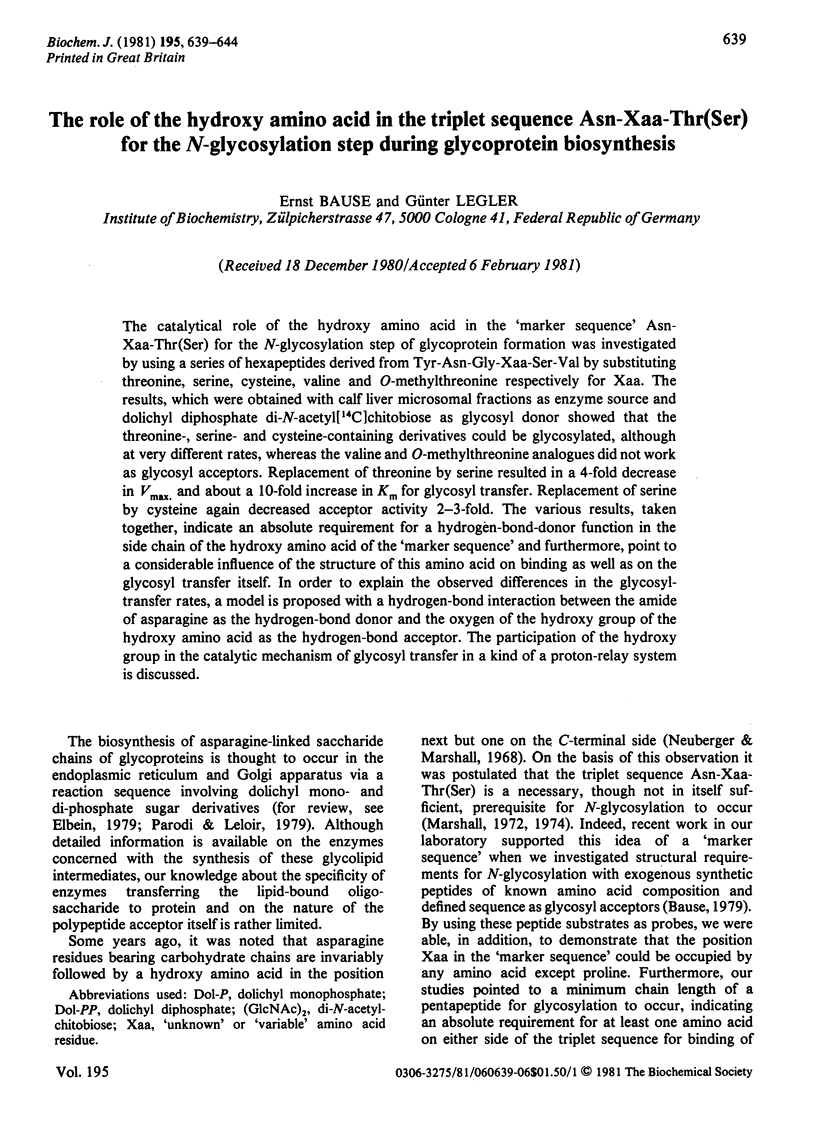Abstract
The catalytical role of the hydroxy amino acid in the "marker sequence" Asn-Xaa-Thr(Ser) for the N-glycosylation step of glycoprotein formation was investigated by using a series of hexapeptides derived from Tyr-Asn-Gly-Xaa-Ser-Val by substituting threonine, serine, cysteine, valine and O-methylthreonine respectively for Xaa. The results, which were obtained with calf liver microsomal fractions as enzyme source and dolichyl diphosphate di-N-acetyl [14C] chitobiose as glycosyl donor showed that the threonine-, serine- and cysteine-containing derivatives could be glycosylated, although at very different rates, whereas the valine and O-methylthreonine analogues did not work as glycosyl acceptors. Replacement of threonine by serine resulted in a 4-fold decrease in Vmax, and about a 10-fold increase in Km for glycosyl transfer. Replacement of serine by cysteine again decreased acceptor activity 2-3-fold. The various results, taken together, indicate an absolute requirement for a hydrogen-bond-donor function in the side chain of the hydroxy amino acid of the "marker sequence" and furthermore, point to a considerable influence of the structure of this amino acid on binding as well as on the glycosyl transfer itself. In order to explain the observed differences in the glycosyl-transfer rates, a model is proposed with a hydrogen-bond interaction between the amide of asparagine as the hydrogen-bond donor and the oxygen of the hydroxy group of the hydroxy amino acid as the hydrogen-bond acceptor. The participation of the hydroxy group in the catalytic mechanism of glycosyl transfer in the kind of proton-relay system is discussed.
Full text
PDF





Selected References
These references are in PubMed. This may not be the complete list of references from this article.
- Bause E., Hettkamp H. Primary structural requirements for N-glycosylation of peptides in rat liver. FEBS Lett. 1979 Dec 15;108(2):341–344. doi: 10.1016/0014-5793(79)80559-1. [DOI] [PubMed] [Google Scholar]
- Bause E., Lehle L. Enzymatic N-glycosylation and O-glycosylation of synthetic peptide acceptors by dolichol-linked sugar derivatives in yeast. Eur J Biochem. 1979 Nov;101(2):531–540. doi: 10.1111/j.1432-1033.1979.tb19748.x. [DOI] [PubMed] [Google Scholar]
- Beeley J. G. Peptide chain conformation and the glycosylation of glycoproteins. Biochem Biophys Res Commun. 1977 Jun 20;76(4):1051–1055. doi: 10.1016/0006-291x(77)90962-7. [DOI] [PubMed] [Google Scholar]
- Hunt L. T., Dayhoff M. O. The occurrence in proteins of the tripeptides Asn-X-Ser and Asn-X-Thr and of bound carbohydrate. Biochem Biophys Res Commun. 1970 May 22;39(4):757–765. doi: 10.1016/0006-291x(70)90270-6. [DOI] [PubMed] [Google Scholar]
- LOWRY O. H., ROSEBROUGH N. J., FARR A. L., RANDALL R. J. Protein measurement with the Folin phenol reagent. J Biol Chem. 1951 Nov;193(1):265–275. [PubMed] [Google Scholar]
- MOULE Y., ROUILLER C., CHAUVEAU J. A biochemical and morphological study of rat liver microsomes. J Biophys Biochem Cytol. 1960 Jun;7:547–558. doi: 10.1083/jcb.7.3.547. [DOI] [PMC free article] [PubMed] [Google Scholar]
- Marshall R. D. Glycoproteins. Annu Rev Biochem. 1972;41:673–702. doi: 10.1146/annurev.bi.41.070172.003325. [DOI] [PubMed] [Google Scholar]
- Marshall R. D. The nature and metabolism of the carbohydrate-peptide linkages of glycoproteins. Biochem Soc Symp. 1974;(40):17–26. [PubMed] [Google Scholar]
- Parodi A. J., Leloir L. F. The role of lipid intermediates in the glycosylation of proteins in the eucaryotic cell. Biochim Biophys Acta. 1979 Apr 23;559(1):1–37. doi: 10.1016/0304-4157(79)90006-6. [DOI] [PubMed] [Google Scholar]
- Ronin C. Solubilization of oligosaccharide transferase and glucosidase activities from thyroid rough microsomes. FEBS Lett. 1980 May 5;113(2):340–344. doi: 10.1016/0014-5793(80)80623-5. [DOI] [PubMed] [Google Scholar]


